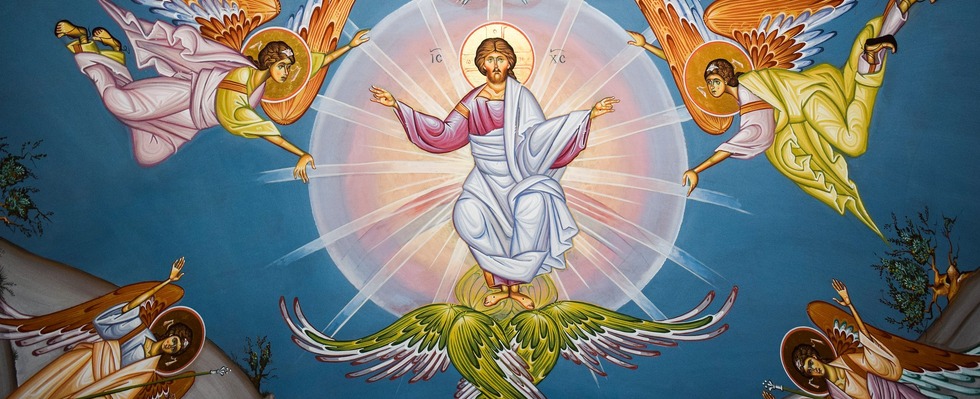The Feast of the Ascension
A sermon for Ascension Day by Fr Guy Nicholls
Last Sunday we heard St John’s account of his vision of the new Jerusalem coming down from God out of heaven, and of the absence of any Temple in that heavenly city. Today we hear of the going up into heaven of that Temple who is the living place of communion with God. For the Temple in Jerusalem was the place where God had promised to meet His people, there to dwell in their midst, and there to answer their prayers.
Now that Temple has been superseded. In the reading of the Passion we heard how, after our Lord’s death, the veil of the Temple was torn in two from top to bottom. What did this strange narrative mean? It was not simply an act of destruction, like the High Priest tearing his robes at the uttering of a blasphemy; it was rather the removal of an obstacle, of something that impeded communication from one side of the veil to the other. The death of Christ was the moment when that impenetrable veil between
God and man had at last been breached for good. This is what the Letter to the Hebrews, which we heard in the second reading, has to tell us. For when Christ died, He was the Temple, He was also the sacrifice, and He was the priest. By His death
He had torn apart sin.
All that remained was for Christ the priest, having torn open the veil in the Temple, to enter in Himself, that is, to enter the presence of the Father. It is this which Christ does in His Ascension. For we see it only as the Apostles saw it in the first reading from the Acts. They saw the Lord depart towards the heavens, but they did not, of course, see Him arrive there. That is what the Letter to the Hebrews is describing for us, for in the Ascension, Christ Who is the Temple, the Lamb of Sacrifice and the Priest, Himself goes up into Heaven to complete what He had already begun on the cross.
Into the presence of his Father
As a man He had already opened the veil, that which separated us from God, and now He went through to the other side, ascending as a man into the presence of His Father. This He does as our priest, our representative with the Father. As the Epistle
to the Hebrews puts it: ‘through the blood of Jesus we have the right to enter the sanctuary by a new way which He had opened for us, a living opening through the curtain, that is to say, His body.’ Now the meaning of the Scripture about Christ’s death is becoming clearer: When the veil of the Temple was torn from top to bottom, this was the veil that is Christ’s sacred body, His human flesh and blood. This being torn apart for us in death became the way through for us to go to heaven.
Christ’s Ascension into heaven is therefore the entry of redeemed humanity into heaven. Christ’s entry into heaven makes possible our own future entry into heaven. The City of God, the living Temple, came down out of heaven at the Incarnation, at the moment when Mary conceived Him in her womb and He became man. Now all that the Incarnation of God as man in Mary’s womb promised is at last fulfilled in Him as He ascends into heaven. He has already died and risen from the dead, now in His Ascension, He who is the living Temple of God, raised to new and indestructible life, is our trailblazer into glory.
To prepare a place for us
He goes to prepare a place for us. By ‘preparing a place,’ He means that by taking our human flesh into heaven, into the living presence of God, He thereby makes a place ready for us. So it is that the Letter to the Hebrews says that ‘Christ has made His appearance once and for all, now at the end of the last age, to do away with sin by sacrificing himself.’ That appearance was what began at the Annunciation to our Lady and was fulfilled on the cross. Now we only await His appearance to bring all things to their conclusion. So the Letter to the Hebrews says: ‘when He, Christ, appears a second time, it will…be to reward with salvation those who are waiting for Him.’
This is why we say in every Mass that ‘we await the blessed hope, and the coming of our Saviour, Jesus Christ.’ He does not merely bring us hope, He is our hope in person. So, as the Letter to the Hebrews says again, ‘let us keep firm in the hope we profess, because the one who made the promise is faithful.’ To conclude, let us recall the magnificent words of the Collect Prayer for the Ascension that we address to the Father: ‘For the Ascension of Christ your Son is our exaltation, and where the Head has gone before in glory, the Body is called to follow in hope.’ Even so, Amen!






